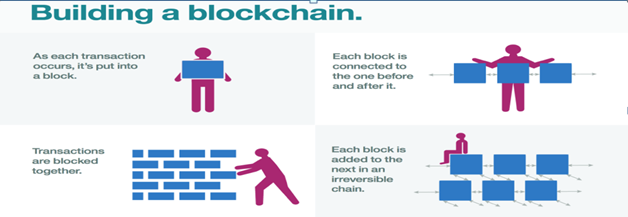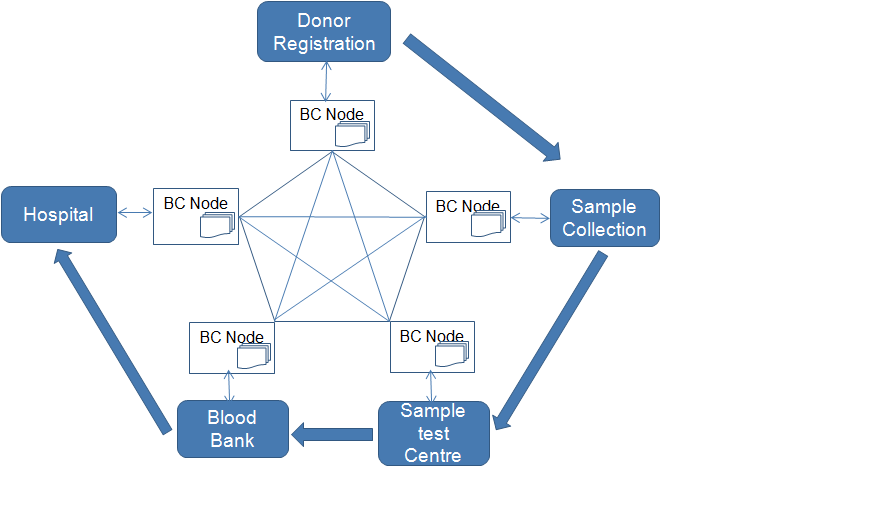
Objective
The objective of using BlockChain Technology (BCT) in blood bank system is to ensure that the patient gets safe blood. This can be achieved by the different entities in the chain; verifying the quality / expiry of blood from the blockchain that provides the trust factor that is required. The donor details could also be verified by the collection centres to ensure unsafe donors are excluded. As a fallout, all the stakeholders will be able to know the availability of blood in different blood banks.
Using BloodChain we will be able to achieve the following benefits
In India, 90% of blood donations are carried out in camps set up by various organizations. While all the donated blood goes through the testing phase and safe blood is separated, sometimes unsafe blood can also penetrate this test and reach the patients infecting them. Though this problem may go unnoticed but the consequences are fatal.
The biggest challenges are setting up a blood repository is donor authentication, identification, and more importantly, donor filtration based on past eligibility records. This makes it important to have a centralized platform for blood donors.
National AIDS Control Organization (NACO) recently reported that 2,234 patients got infected with HIV cause of bad blood transfusion in the last 16 months. The figure stands at more than 14000 infections in the last 7 years. In spite of the latest testing methodologies leading to lesser window period of these fatal diseases, the problems are still increasing. One of the key reasons has been the absence of centralized blood donor registry and unique donor identification program. With no centralized blood donor registry in place, blood donors found reactive during their previous donation at a particular blood bank again end up donating at multiple blood donation camps. Also a lot of under quarantine donors end up donating again.
Another challenge in blood cycle management is the gap in demand and supply. On the one hand 30% of the patients don’t get the components which they are in need of, and on the other hand 10-12% of the components get wasted due to expiry.
Most blood donation drives are occasion driven or time driven with less co-relation with the actual demand at that time. The need is to get all the stakeholders of the blood ecosystem on a single platform and align the drives with the actual regional requirements, develop a solution which helped address these challenges with the latest technological advancement as well as align with the actual working on the ground.
Blood Chain brings all the key stakeholders of blood cycle management blood banks, donors, blood collection, Testing Centres, hospitals and patients on one platform.
BlockChain provides a shared ledger technology that participants in a business network can use to record the history of business transactions that cannot be altered. BlockChain provides a single point of truth: a shared, tamper-evident ledger. Blockchain uses consensus to commit transactions to the ledger, the results are final. Each member has a copy of the same ledger, so asset provenance and traceability are transparent and trusted. Blockchain can be applied to any industry. BlockChain is a distributed and replicated data structure that is shared among the members of a network. Multiple nodes connect to a block chain and make up the network. Each node can make transactional changes and each block in the chain represents a list of transactions and a hash to the previous block, except for the first block.

The Hyperledger Sawtooth is an enterprise blockchain platform for building, deploying, and running distributed ledgers. The smart contract abstraction provided by the Sawtooth allows application developers to code in a language of their choice. The platform facilitates the development of blockchain solutions by separating the core system from the application domain. Programmers can specify the business rules appropriate for their application, using the language they want, with no need to know the underlying design of the core system. Sawtooth’s core design allows applications to choose the transaction rules, permissioning, and consensus algorithms that support their unique business requirements.
BloodBank use case is recording transactions right from Donor registration, to Hospital, and other important properties of blood like group, testing remark, expiry date, temperature maintained, on blockchain. (Status, availability of blood, assurance on availability-quality)

Entities involved
Supply Chain Management
Distributed Ledger
Traditionally, transactions of stakeholders are offered through a trusted third-party in Liquor Industry. The main disadvantage of having a third-party is that trust is required in this party not to misuse its power and to faithfully provide its services. The main risk of having a third party trust in Liquor Industry is that an issuer can gain to control over the stakeholders, which enables the stakeholders compromise the issuer’s inefficient services. The current business ledgers being used today are inadequate from multiple points of view. They are costly and subject to misuse and tampering, and lack of transparency as well as susceptibility to corruption and fraud. These uncertainties lead to disputes between stakeholders. As a consequence, having to resolve disputes, the reverse transactions or refund for transaction maybe expensive. Furthermore, the current system is also delayed while reconciling the different stake-holders ledger records and which leads to making wrong business decision and negligence. These risks and dangers perhaps contribute to the botched business opportunities.
While using BlockChain technology in distributed ledger system, each record in the distributed ledger has a timestamp and unique cryptographic signature, thus making a permanent record of all stakeholders transactions in Blockchain Network. In addition to that a record on the Blockchain would be initiated and every other stakeholder in the deal will be able to see that information as soon as it is uploaded.
BlockChain Benefits for B2B & B2C

Different entities interact with the existing system each other
